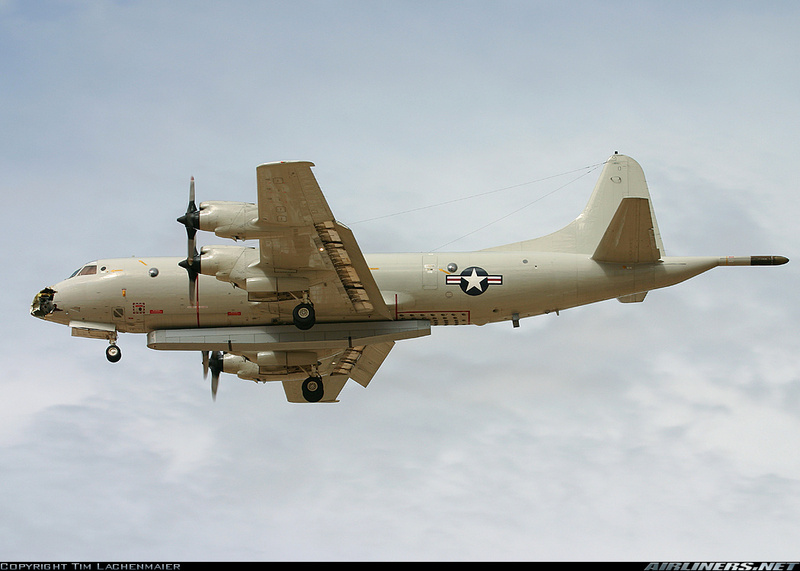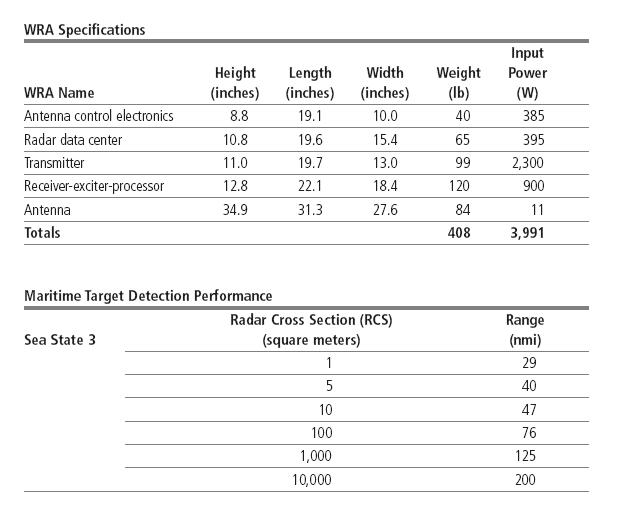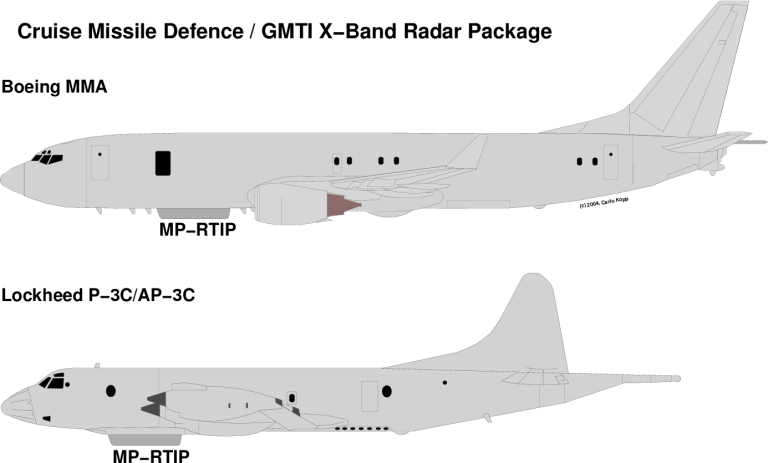보충자료
김병기 | 2007-08-05 23:25:07
조회 18243 | 추천 6 | 다운로드 9
===> 위에 소개한 기사 이전에 5 월에 소개되었던 LSRS 에관한 기사와 기사중에 인용되었던 하픈 유도관련 보잉사 소개보도문입니다. 재미있는 것은 이 레이더는 AESA 이지만 P-8 에 장착되는 AN/APS-10 레이더는 능동형이 아니라 수동형 위상배열 레이더입니다. 물론 AN/APY-10 는 LSRS 처럼 육상 이동표적 추적능력은 없는 해상감시용 레이더입니다. 그래도 해상 탐지거리가 P3C 에 장착된 AN/APS-137 보다 훨씬 크네요
중량은 훨씬 작은데 말입니다.
1 번 사진은 P3C 에 장착한 APS-149 LSRS 레이더의 모습입니다.
2 번 사진은 P-8 에 장착되는 AN/APY-10 의 스펙입니다.
3 번 사진은 호주군이 구상했던 MP-RTIP 레이더의 장착 구상도입니다.
4 번 사진은 AN/APY-10 레이더 사진입니다.
=======================================
May 17, 2007
Not-Quite-Secret Radar
New to the not-quite-secret file is the Raytheon-Boeing Littoral Surveillance Radar System (LSRS), a wide-aperture active electronically scanned array (AESA) surveillance radar that is now operational on P-3 Orions flown by VP-46 out of Whidbey Island. LSRS has been used in exercises in the Pacific and operationally in Southwest Asia. It's been mentioned in Jane's and a number of spotter sites, notably the Netherlands-based P-3 Orion Research Group which estimates that at least five aircraft have been modified.
The Boeing-Raytheon team -- the program's umbrella name is Advanced Sensor Technology (AST) -- accomplished 2800 hours of testing, apparently based at Love Field in Dallas, before achieving early operational capability in 2005, according to this official publication (pdf, last page).
LSRS is designed to provide targeting-grade tracking of moving targets on land and at sea. In September, one of the LSRS P-3s supported a test of the Navy/Boeing SLAM-ER missile against a moving target, a simulated SA-10 missile launcher, at China Lake; follow-on tests were to use the same combination of systems against a maneuvering ground target. In 2010, LSRS is due to support a large-scale Joint Surface Warfare (JSuW) demonstration, providing targeting updates to air- and ship-launched weapons ranging from JDAMs to Harpoons.
Raytheon's role in LSRS is an upset of Northrop Grumman, which had previously dominated Navy trials of moving target indication (MTI) radars through the Gray Wolf and Hairy Buffalo demonstrations. (Both were Norden-legacy programs, Gray Wolf on an S-3 and Hairy Buffalo on a P-3.) LSRS presumably uses the "tile" AESA technology used successfully on the Super Hornet and JSF radars and also has high-resolution synthetic aperture radar (SAR) modes.
But the impact of LSRS may run beyond the Navy. In early 2003, Boeing changed its proposed design for the Multi-Mission Maritime Aircraft (MMA), using the 737-800 as the basis for the aircraft instead of the shorter-bodied 737-700. (MMA is now the P-8A Poseidon.) At the same time, Boeing located the MMA's weapon bay in the rear fuselage. The change was to accommodate a specific, classified capability, Boeing said. Given that Boeing is on the LSRS team it is not hard to guess what that capability is. The long, shallow LSRS antenna is sized for the P-8A's long, low-slung forward fuselage.
Meanwhile, the USAF's planned follow-on to the E-8 Joint STARS, the E-10A, was canceled in the FY2008 budget, and the USAF is still studying the cost of adapting the E-10's radar to the JSTARS platform. With LSRS, though, the P-8A is a modern, long-range, jet-powered platform with an AESA MTI radar and the necessary back-end systems - computers, operator consoles and communications - to support it. Moreover, the USAF has increasingly been evaluating the Joint STARS in the maritime and littoral environment.
--Bill Sweetman
(Photo credit: Tim Lachenmaier)
----------------------------
Boeing Scores Direct Hit in SLAM-ER Land Moving Target Test
ST. LOUIS, Oct. 05, 2006 -- Boeing's [NYSE: BA] Standoff Land Attack Missile-Expanded Response (SLAM-ER) weapon system scored a direct hit against a moving, remotely-controlled land target during a recent flight test at the U.S. Naval Air Warfare Center, China Lake, Calif.
The test occurred on Sept. 13 as part of the U.S. Navy's SLAM-ER developmental/operational flight test program. The launch followed a successful developmental test flight on June 1 that used simulated command and control aircraft targeting data to engage a remotely-controlled Shahab 3 missile launcher mock-up.
"SLAM-ER now has the flexibility to engage both fixed and moving land targets," said Boeing Naval Weapons Director Jan Browne. "This demonstrated capability greatly enhances the Navy's ability to engage high-interest mobile targets in today's varied threat environment."
For the test, a Littoral Surveillance Radar System-equipped aircraft sent real-time targeting data to the Boeing-built F/A-18 aircraft, which relayed the data to the SLAM-ER after the weapon's launch. The SLAM-ER acquired and impacted a simulated SA-10 missile launcher in a desert environment. A follow-on test will launch the SLAM-ER against a simulated SA-3 missile launcher that will maneuver and change speeds like an operational target.
SLAM-ER is a highly adaptable day/night, all-weather, over-the-horizon precision strike missile capable of hitting stationary or moving targets on land or at sea. The Navy recognizes SLAM-ER as the most accurate weapon in its inventory.
The Navy will complete its operational testing of SLAM-ER's moving target capability later this year.
-----------------------------------
------------------------------------------------
작성자 : SW
내용상 Astor에 사용된 장비와 유사하지 않을까 추측이 되는군요...
>P-3C에 장착 가능이면, 향후 우리도 주목해야할 내용으로 보입니다.
>
>DATE:03/08/07
>SOURCE:Flight International
>
>US Navy surveillance system developed to rival Northrop Grumman's JSTARS
>By Stephen Trimble
>
>The US Navy has secretly developed and deployed a new airborne surveillance system that
>rivals the capability of Northrop Grumman's E-8C JSTARS.
>
>**미해군이 비밀리에 새로운 항공정찰장비를 개발하였으며, E-8C JSTARS 의
> 능력에 버금가는 것 이라고...
>
>Flight International has obtained new details of the USN's Littoral Surveillance Radar System
>(LSRS), which appears by name only in a handful of official documents, but is never described.
>
>**극히 소수의 자료에서 미해군의 Littoral Surveillance Radar System 으로 언급은
> 되었으나, 설명이 없언던 내용에 대해 새로운 내용을 입수하였다고...
>
>LSRS is the product of an industry team including Boeing, Raytheon and L-3 Communications,
>with Boeing serving as the systems integrator. Raytheon supplies the previously undisclosed
>APS-149 sensor and L-3 Communications is providing maintenance and systems support.
>
>**LSRS는 Boeing, Raytheon, L-3 Communications 3사를 포함한 업체 연합의 산물.
> 보잉이 전체 통합을하고, 레이시온이 비공개되어온 APS-149 레이다를, L-3가
> 유지, 보수, 지원을 한다고...
>
>The team has delivered seven LSRS units to the USN. The sensor's lengthy canoe-type radome
>is able to be installed on the underfuselage of a subset of the Lockheed Martin P-3C Orion
>fleet.
>
>** 7대분의 LSRS 가 미해군에 납품되었으며, 카누 모양의 길다란 형태의 레이다를
> P-3C 오리온 동체 하부에 장착할수 있다고...
>
>Sixteen P-3Cs equipped with the block modification upgrade programme (BMUP) can operate
>the LSRS, which has accumulated more than 2,800h in flight as of February 2007, according to
>a government document.
>
>**16대의 block modification upgrade programme (BMUP)를 통해 개량된 P-3C 는
> LSRS를 운용가능 하다고...
>
>The APS-149 is an active electronically scanned array (AESA) radar that can track and target
>land and maritime targets, both stationary and moving. The system has been used in
>demonstrations to cue a Boeing AGM-84K Standoff Land Attack Missile - Expanded Response
>to strike a simulated launcher for an Iranian Shahab-3 ballistic missile.
>
>**APS-149는 AESA radar로 육상, 해상의 고정 및 이동 목표를 추적할수 있으며,
> 이 장비는 AGM-84K SLAM-ER 로 이란의 Shahab-3 탄도탄 발사대에 대한
> 모의 공격시 사용되었다고...
>
>It is not clear whether the system can be transferred to the P-3C's future replacement - the
>Boeing P-8A Poseidon that is now in development. A USN P-8A programme official recently
>told Flight International that the service would resist any effort to install the LSRS due to
>concerns about diluting the aircraft's core anti-submarine warfare mission.
>
>**P-3C의 대체기인, 현재 개발중인 P-8A 포세이돈에 장착이 가능한지는
> 확실치 않다고... 미해군의 P-8A program 관계자는 LSRS 장착 시도는
> 동 기체의 핵심인 대잠 임무를 약화시킬수 있다며, 거부감을 표시하였다고...
>
>
>
중량은 훨씬 작은데 말입니다.
1 번 사진은 P3C 에 장착한 APS-149 LSRS 레이더의 모습입니다.
2 번 사진은 P-8 에 장착되는 AN/APY-10 의 스펙입니다.
3 번 사진은 호주군이 구상했던 MP-RTIP 레이더의 장착 구상도입니다.
4 번 사진은 AN/APY-10 레이더 사진입니다.
=======================================
May 17, 2007
Not-Quite-Secret Radar
New to the not-quite-secret file is the Raytheon-Boeing Littoral Surveillance Radar System (LSRS), a wide-aperture active electronically scanned array (AESA) surveillance radar that is now operational on P-3 Orions flown by VP-46 out of Whidbey Island. LSRS has been used in exercises in the Pacific and operationally in Southwest Asia. It's been mentioned in Jane's and a number of spotter sites, notably the Netherlands-based P-3 Orion Research Group which estimates that at least five aircraft have been modified.
The Boeing-Raytheon team -- the program's umbrella name is Advanced Sensor Technology (AST) -- accomplished 2800 hours of testing, apparently based at Love Field in Dallas, before achieving early operational capability in 2005, according to this official publication (pdf, last page).
LSRS is designed to provide targeting-grade tracking of moving targets on land and at sea. In September, one of the LSRS P-3s supported a test of the Navy/Boeing SLAM-ER missile against a moving target, a simulated SA-10 missile launcher, at China Lake; follow-on tests were to use the same combination of systems against a maneuvering ground target. In 2010, LSRS is due to support a large-scale Joint Surface Warfare (JSuW) demonstration, providing targeting updates to air- and ship-launched weapons ranging from JDAMs to Harpoons.
Raytheon's role in LSRS is an upset of Northrop Grumman, which had previously dominated Navy trials of moving target indication (MTI) radars through the Gray Wolf and Hairy Buffalo demonstrations. (Both were Norden-legacy programs, Gray Wolf on an S-3 and Hairy Buffalo on a P-3.) LSRS presumably uses the "tile" AESA technology used successfully on the Super Hornet and JSF radars and also has high-resolution synthetic aperture radar (SAR) modes.
But the impact of LSRS may run beyond the Navy. In early 2003, Boeing changed its proposed design for the Multi-Mission Maritime Aircraft (MMA), using the 737-800 as the basis for the aircraft instead of the shorter-bodied 737-700. (MMA is now the P-8A Poseidon.) At the same time, Boeing located the MMA's weapon bay in the rear fuselage. The change was to accommodate a specific, classified capability, Boeing said. Given that Boeing is on the LSRS team it is not hard to guess what that capability is. The long, shallow LSRS antenna is sized for the P-8A's long, low-slung forward fuselage.
Meanwhile, the USAF's planned follow-on to the E-8 Joint STARS, the E-10A, was canceled in the FY2008 budget, and the USAF is still studying the cost of adapting the E-10's radar to the JSTARS platform. With LSRS, though, the P-8A is a modern, long-range, jet-powered platform with an AESA MTI radar and the necessary back-end systems - computers, operator consoles and communications - to support it. Moreover, the USAF has increasingly been evaluating the Joint STARS in the maritime and littoral environment.
--Bill Sweetman
(Photo credit: Tim Lachenmaier)
----------------------------
Boeing Scores Direct Hit in SLAM-ER Land Moving Target Test
ST. LOUIS, Oct. 05, 2006 -- Boeing's [NYSE: BA] Standoff Land Attack Missile-Expanded Response (SLAM-ER) weapon system scored a direct hit against a moving, remotely-controlled land target during a recent flight test at the U.S. Naval Air Warfare Center, China Lake, Calif.
The test occurred on Sept. 13 as part of the U.S. Navy's SLAM-ER developmental/operational flight test program. The launch followed a successful developmental test flight on June 1 that used simulated command and control aircraft targeting data to engage a remotely-controlled Shahab 3 missile launcher mock-up.
"SLAM-ER now has the flexibility to engage both fixed and moving land targets," said Boeing Naval Weapons Director Jan Browne. "This demonstrated capability greatly enhances the Navy's ability to engage high-interest mobile targets in today's varied threat environment."
For the test, a Littoral Surveillance Radar System-equipped aircraft sent real-time targeting data to the Boeing-built F/A-18 aircraft, which relayed the data to the SLAM-ER after the weapon's launch. The SLAM-ER acquired and impacted a simulated SA-10 missile launcher in a desert environment. A follow-on test will launch the SLAM-ER against a simulated SA-3 missile launcher that will maneuver and change speeds like an operational target.
SLAM-ER is a highly adaptable day/night, all-weather, over-the-horizon precision strike missile capable of hitting stationary or moving targets on land or at sea. The Navy recognizes SLAM-ER as the most accurate weapon in its inventory.
The Navy will complete its operational testing of SLAM-ER's moving target capability later this year.
-----------------------------------
------------------------------------------------
작성자 : SW
내용상 Astor에 사용된 장비와 유사하지 않을까 추측이 되는군요...
>P-3C에 장착 가능이면, 향후 우리도 주목해야할 내용으로 보입니다.
>
>DATE:03/08/07
>SOURCE:Flight International
>
>US Navy surveillance system developed to rival Northrop Grumman's JSTARS
>By Stephen Trimble
>
>The US Navy has secretly developed and deployed a new airborne surveillance system that
>rivals the capability of Northrop Grumman's E-8C JSTARS.
>
>**미해군이 비밀리에 새로운 항공정찰장비를 개발하였으며, E-8C JSTARS 의
> 능력에 버금가는 것 이라고...
>
>Flight International has obtained new details of the USN's Littoral Surveillance Radar System
>(LSRS), which appears by name only in a handful of official documents, but is never described.
>
>**극히 소수의 자료에서 미해군의 Littoral Surveillance Radar System 으로 언급은
> 되었으나, 설명이 없언던 내용에 대해 새로운 내용을 입수하였다고...
>
>LSRS is the product of an industry team including Boeing, Raytheon and L-3 Communications,
>with Boeing serving as the systems integrator. Raytheon supplies the previously undisclosed
>APS-149 sensor and L-3 Communications is providing maintenance and systems support.
>
>**LSRS는 Boeing, Raytheon, L-3 Communications 3사를 포함한 업체 연합의 산물.
> 보잉이 전체 통합을하고, 레이시온이 비공개되어온 APS-149 레이다를, L-3가
> 유지, 보수, 지원을 한다고...
>
>The team has delivered seven LSRS units to the USN. The sensor's lengthy canoe-type radome
>is able to be installed on the underfuselage of a subset of the Lockheed Martin P-3C Orion
>fleet.
>
>** 7대분의 LSRS 가 미해군에 납품되었으며, 카누 모양의 길다란 형태의 레이다를
> P-3C 오리온 동체 하부에 장착할수 있다고...
>
>Sixteen P-3Cs equipped with the block modification upgrade programme (BMUP) can operate
>the LSRS, which has accumulated more than 2,800h in flight as of February 2007, according to
>a government document.
>
>**16대의 block modification upgrade programme (BMUP)를 통해 개량된 P-3C 는
> LSRS를 운용가능 하다고...
>
>The APS-149 is an active electronically scanned array (AESA) radar that can track and target
>land and maritime targets, both stationary and moving. The system has been used in
>demonstrations to cue a Boeing AGM-84K Standoff Land Attack Missile - Expanded Response
>to strike a simulated launcher for an Iranian Shahab-3 ballistic missile.
>
>**APS-149는 AESA radar로 육상, 해상의 고정 및 이동 목표를 추적할수 있으며,
> 이 장비는 AGM-84K SLAM-ER 로 이란의 Shahab-3 탄도탄 발사대에 대한
> 모의 공격시 사용되었다고...
>
>It is not clear whether the system can be transferred to the P-3C's future replacement - the
>Boeing P-8A Poseidon that is now in development. A USN P-8A programme official recently
>told Flight International that the service would resist any effort to install the LSRS due to
>concerns about diluting the aircraft's core anti-submarine warfare mission.
>
>**P-3C의 대체기인, 현재 개발중인 P-8A 포세이돈에 장착이 가능한지는
> 확실치 않다고... 미해군의 P-8A program 관계자는 LSRS 장착 시도는
> 동 기체의 핵심인 대잠 임무를 약화시킬수 있다며, 거부감을 표시하였다고...
>
>
>









 1
1


댓글 [7]
앵속 | 2007-08-06 | 추천 0
김병기 | 2007-08-06 | 추천 0
김병기 | 2007-08-06 | 추천 0
최현호(폴라리스) | 2007-08-06 | 추천 0
코털3mm | 2007-08-06 | 추천 0
The Undertaker | 2007-08-06 | 추천 0
김병기 | 2007-08-05 | 추천 0